Digital Branding Strategies
Understanding Marketing and Branding Agencies: A Complete Tutorial for Brand Managers
Overview
Marketing and branding agencies serve as pivotal partners in shaping business identities and amplifying market visibility through strategic functions like market research and digital marketing. By articulating a brand’s unique value proposition and fostering engagement with target audiences, these agencies empower their clients to realize measurable business outcomes.
This is exemplified by successful case studies, such as WonderEight’s collaboration with notable clients like Quaker Oats, showcasing the tangible impact of effective branding strategies.
Introduction
In the dynamic world of business, understanding the distinction between marketing and branding agencies is essential for companies aiming to enhance their market presence and identity. As organizations navigate the complexities of consumer engagement and brand management, these specialized firms emerge as pivotal partners in crafting effective strategies that resonate with target audiences.
With the rise of digital platforms and evolving consumer expectations, grasping the functions and benefits of branding agencies becomes increasingly critical. This article explores:
- The essential roles these agencies fulfill
- The criteria for selecting the right partner
- The metrics for measuring success
Ultimately, guiding brand managers towards informed decisions that drive business growth.
Defining Marketing and Branding Agencies: Key Concepts and Functions
Marketing and branding agencies are pivotal in helping businesses develop and implement strategies that enhance their image and market visibility. These specialized firms undertake a range of functions, including in-depth market research, strategy development, creative design, and digital marketing initiatives. Their primary objective is to empower clients to articulate their unique value propositions effectively, engage with target audiences, and achieve measurable business outcomes.
Recent statistics underscore the critical role of identity in consumer recognition; for example, a signature color can boost recognition by as much as 80%. As noted by Exploding Topics, this highlights the significance of strategic marketing efforts in cultivating customer loyalty and driving long-term success. As we advance through 2025, the relevance of marketing and branding agencies continues to grow, with companies increasingly relying on these agencies to navigate the complexities of brand management in a competitive landscape.
Expert insights emphasize that effective brand identity transcends aesthetics; it encompasses a thorough understanding of market dynamics and consumer behavior. Agencies like WonderEight exemplify this approach, offering a comprehensive suite of services, including:
- Social media planning
- Online and offline campaigns
- Events and activations
- Digital audits
- Website and app design and development
- SEO consulting
- E-commerce CRM planning
Their innovative solutions merge technology with creative strategies, ensuring that promotional efforts are not only visually compelling but also strategically sound.
For instance, in their collaboration with Quaker Oats, WonderEight designed a tailored marketing strategy that significantly bolstered the company’s market presence and consumer engagement, showcasing the firm’s prowess in strategic positioning.
Moreover, emerging trends indicate that small prompts, such as highlighting popular products, can substantially influence conversion rates, further illustrating the nuanced strategies employed by marketing firms. WonderEight’s distinctive commitment to integrating creativity with technology ensures that their solutions enhance corporate identity and facilitate business growth. For product managers, understanding these dynamics is crucial for unlocking the full potential of marketing and branding agencies like WonderEight.
To discover how WonderEight can elevate your marketing strategy, contact us today.
Distinguishing Between Branding, Marketing, and Advertising Agencies
Marketing and branding agencies are pivotal in creating and maintaining a company’s identity, encompassing its visual components, messaging, and overarching narrative. Establishing a robust brand foundation is essential for long-term success in this domain. In contrast, these agencies are also tasked with promoting products or services through diverse channels, driving sales and enhancing customer engagement.
Their strategies frequently include digital marketing, social media management, and event activations, all of which are critical in today’s competitive landscape. Conversely, promotional firms concentrate on the development and execution of paid marketing campaigns aimed at specific target audiences, utilizing traditional media, digital ads, and social media promotions.
Understanding these distinctions is vital for managers, enabling them to select the appropriate firm based on their unique objectives—be it product development, market penetration, or targeted advertising campaigns.
Current trends indicate a growing specialization within the firm landscape, with many organizations, including marketing and branding agencies, focusing on either identity creation or marketing to better serve their clients. For instance, the digital advertising industry was projected to reach a market size of $20.7 billion by 2022, highlighting the increasing demand for digital marketing services as businesses transition online. Notably, the United States leads in social media advertising spending at $72.3 billion, closely followed by China at $71.4 billion, underscoring the significance of digital marketing in the current environment.
Moreover, statistics reveal that 43% of consumers are inclined to spend on companies they are loyal to, while 39% are willing to switch to brands that demonstrate transparency.
When choosing between marketing and branding agencies, managers must evaluate their specific needs and objectives. Successful identity agency projects, such as those executed by WonderEight for brands like Mirinda and Quaker Oats, exemplify the effectiveness of tailored strategies in crafting impactful experiences. Insights from marketing and branding agencies emphasize the necessity of explicitly defining an identity, as this foundational work underpins all promotional efforts.
As Laura Kloot aptly states, ‘By clearly defining who you are, you are establishing a strong foundation that will underpin every aspect of your marketing efforts.’ This statement highlights the importance of selecting the right marketing and branding agencies based on the company’s identity.
In 2025, the distinctions among branding, marketing, and advertising firms continue to evolve, with a significant emphasis on the merger of technology and creativity. The marketing sector is projected to grow to $769.9 billion by 2024, reflecting a robust recovery from a slight decline in 2020 due to the pandemic, largely driven by advancements in artificial intelligence. This landscape presents product managers with numerous choices, making it essential to align organizational capabilities with product goals for optimal outcomes.
WonderEight sets itself apart in this environment by offering creative identity and digital solutions through marketing and branding agencies tailored to meet the unique needs of each client, ensuring that managers can effectively navigate the complexities of today’s market.
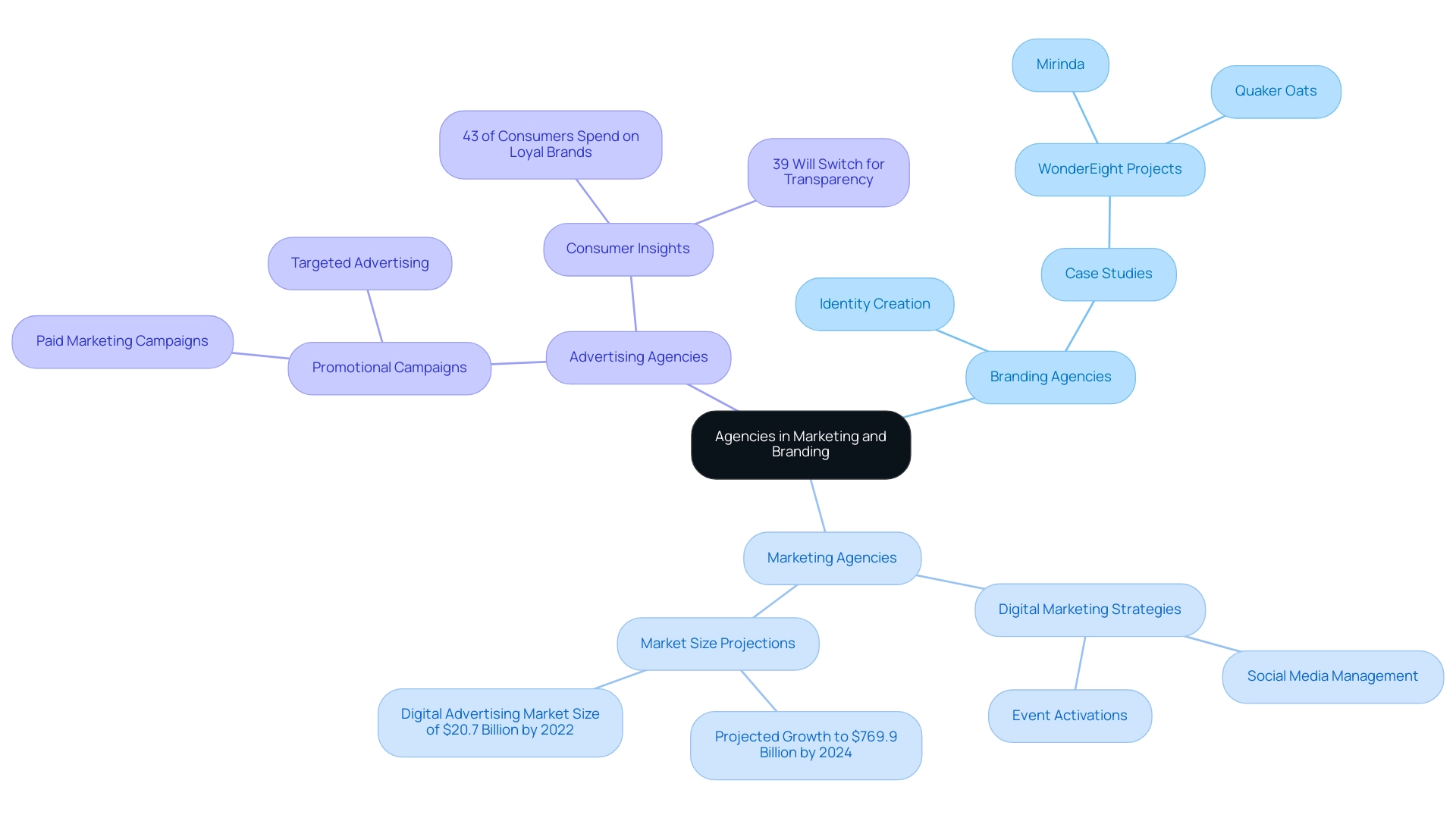
Core Services Provided by Branding Agencies: What to Expect
Marketing and branding agencies are indispensable allies for businesses striving to forge a robust market presence. WonderEight, a comprehensive identity and digital solutions firm, offers a wide range of services, including:
- Identity development
- Visual design
- Market research
- Messaging
- Digital presence management
Additionally, WonderEight provides specialized services such as:
- Packaging design
- Environmental marketing
- Social media strategy
All crucial for crafting a cohesive identity experience.
As we look to 2025, the landscape of agency services is evolving, highlighting the fusion of technology and creativity. A signature color, for example, can enhance recognition by up to 80%, illustrating the vital role of visual identity in shaping consumer perception. Moreover, a strong employer identity has been shown to boost employee retention by as much as 28%, significantly lowering hiring costs and enhancing overall reputation.
This underscores the critical importance of employer reputation within a comprehensive marketing strategy.
The development of an effective marketing plan transcends mere aesthetics; it demands a deep understanding of market dynamics and consumer behavior. A case study on employer identity reveals that 69% of job candidates turn down offers from companies with poor reputations, reinforcing the competitive edge that a positive employer image can confer in attracting top talent.
Industry leaders assert that the effective identity strategy development services provided by marketing and branding agencies, such as those from WonderEight, are essential for businesses navigating the complexities of the market. As consumer expectations continue to escalate, companies must embrace a human element and ensure consistent messaging to resonate with their audience. This strategy not only cultivates loyalty but also encourages consumers to switch to more transparent companies, with 39% expressing a willingness to do so.
The imperative for companies to embody transparency and authenticity is more critical than ever as we approach 2024.
By grasping these core services and their implications, managers can align their objectives with the offerings of WonderEight, maximizing the effectiveness of their marketing efforts.
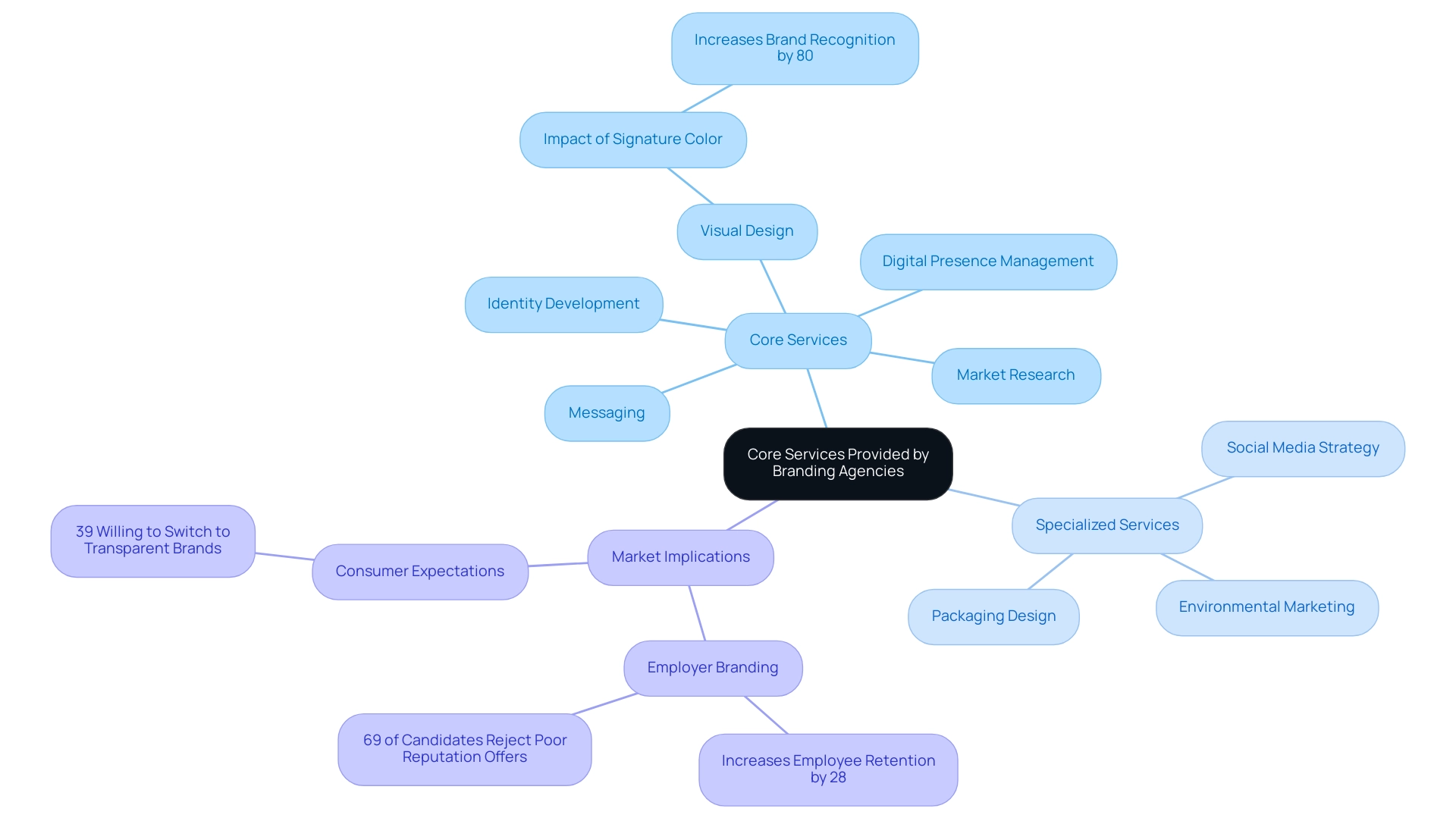
Why Brand Managers Should Consider Partnering with a Branding Agency
Collaborating with marketing and branding agencies provides managers with invaluable access to specialized knowledge, innovative strategies, and new viewpoints that may not be readily available within their organizations. This strategic partnership significantly streamlines marketing efforts, enhances brand visibility, and ensures consistency across all promotional channels. In 2025, the advantages of such collaborations are more pronounced, as 70% of B2B decision-makers have chosen to outsource key services to third parties, underscoring a growing trend towards leveraging external expertise.
Marketing and branding agencies excel at navigating complex market dynamics and understanding consumer behaviors, leading to more effective branding outcomes. For example, companies engaged in co-selling partnerships have reported a remarkable 77% increase in profits, illustrating the financial benefits of collaborative approaches. This is further exemplified by Everflow, which successfully shortened its sales cycles by 44% through co-marketing and co-selling campaigns executed with Crossbeam.
As Brandon Greer, Senior Manager of Corporate Development at HubSpot, stated, “Using Crossbeam, I can more precisely identify the percentage of our base that is already a subscriber of The Hustle’s content.” This highlights the precision and effectiveness achievable through collaborative partnerships.
WonderEight offers a variety of services, including evaluations and digital marketing plans, that can boost visibility and enhance marketing coherence. Effective partnerships not only improve identity perception but also lead to quantifiable outcomes, as evidenced by significant case studies such as the identity enhancement for Castania, where organizational involvement was crucial in reshaping strategies.
In conclusion, collaborating with marketing and branding agencies in 2025 is not merely a strategic decision; it is essential for product managers aiming to thrive in a competitive landscape. The combination of professional expertise and innovative strategies, such as those provided by WonderEight, can significantly enhance market positioning and visibility, ultimately driving greater success in achieving business goals.
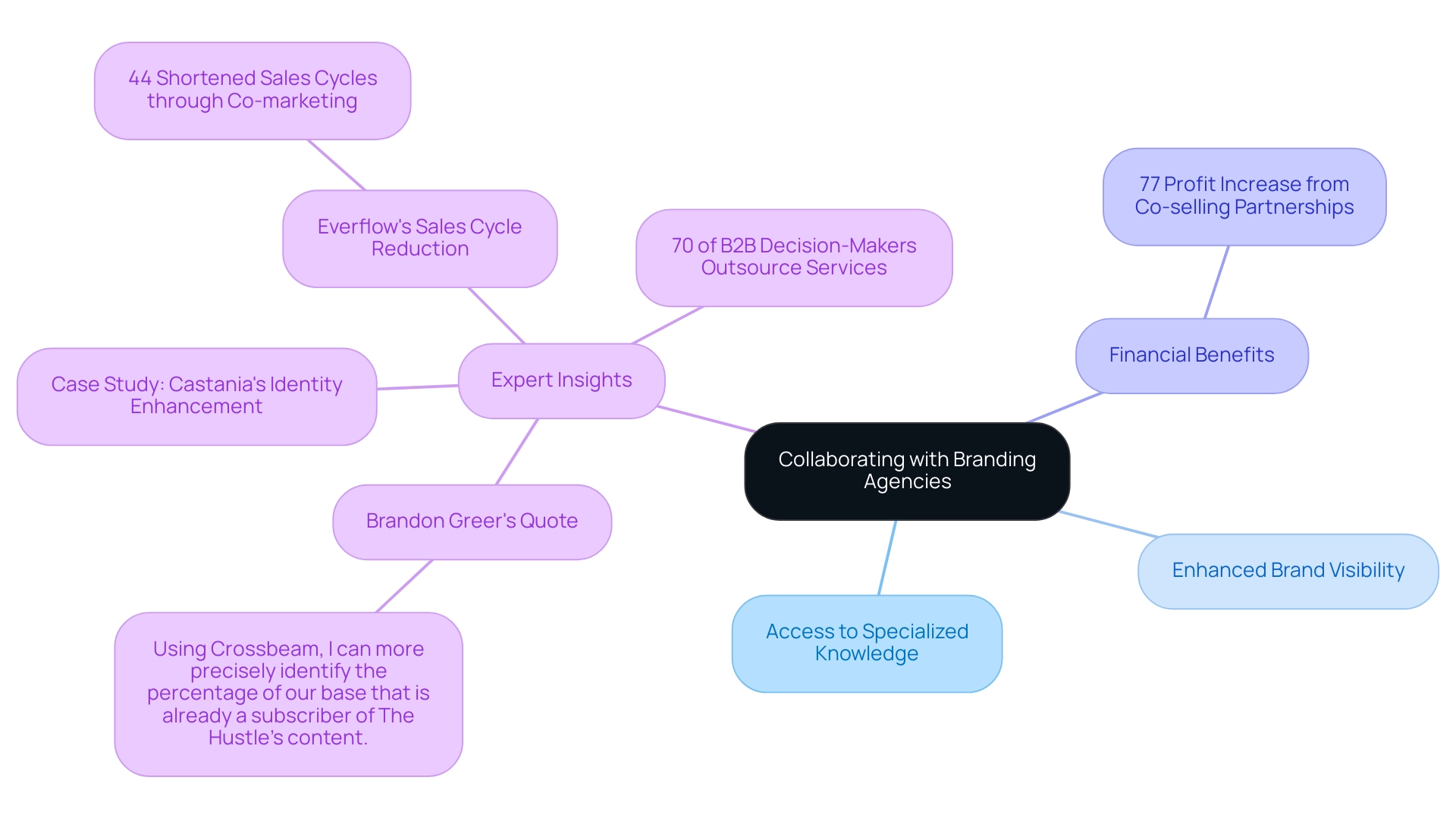
Criteria for Selecting the Right Branding Agency: A Guide for Brand Managers
Choosing the right marketing and branding agencies is a critical decision for brand managers, necessitating careful consideration of several key criteria. A firm’s portfolio serves as a window into its capabilities and creative approach. A diverse and well-executed portfolio not only showcases the agency’s design aesthetic but also reflects its ability to deliver results across various industries.
WonderEight, for instance, has successfully collaborated with clients across multiple sectors, demonstrating its versatility and expertise in crafting tailored branding solutions. Data indicates that posts with images generate 650% higher engagement than text-only posts, underscoring the importance of visual storytelling in branding.
Industry experience is another vital factor. Agencies that have successfully navigated similar markets or challenges can provide valuable insights and approaches tailored to specific needs. Client testimonials further enhance this evaluation, providing real-world evidence of a firm’s effectiveness. Research indicates that 37% of consumers establish loyalty to a label after making five purchases, emphasizing the significance of cultivating customer relationships—something an experienced firm like WonderEight can support through effective branding strategies. For instance, WonderEight’s innovative digital marketing solutions have assisted clients in attaining considerable engagement and loyalty.
Cultural fit is equally crucial; the organization’s values and working style should correspond with those of the company. This alignment fosters a collaborative environment, essential for a productive partnership. Additionally, evaluating the organization’s communication style and responsiveness can significantly influence the overall experience. A marketing firm that emphasizes clear communication and prompt feedback can help guarantee that projects remain on schedule and fulfill timelines.
In 2025, marketing managers should also contemplate the changing environment of branding firms. Criteria such as adaptability to digital trends, innovative approaches to strategy, and a proven track record of successful partnerships are crucial. For instance, Vianca Meyer’s social media campaigns for a travel website resulted in a remarkable 60% boost in total traffic, demonstrating the tangible benefits of choosing a firm with a strong digital marketing focus.
Moreover, as highlighted by Business Insider, the amount companies invest in logo design can vary from completely free to millions, underscoring the financial aspects involved in choosing a firm.
Ultimately, by carefully assessing these elements—portfolio quality, industry experience, client testimonials, cultural fit, and communication style—marketing managers within marketing and branding agencies can make informed choices that result in successful branding initiatives and long-term collaborations. Insights from industry leaders like Courtney Bozigian, Head of Brand Development at Digital Silk, can provide valuable guidance in navigating these criteria effectively. By considering agencies like WonderEight, which provides a comprehensive range of services from evaluations to digital marketing approaches, managers can ensure they select a partner capable of delivering impactful results.
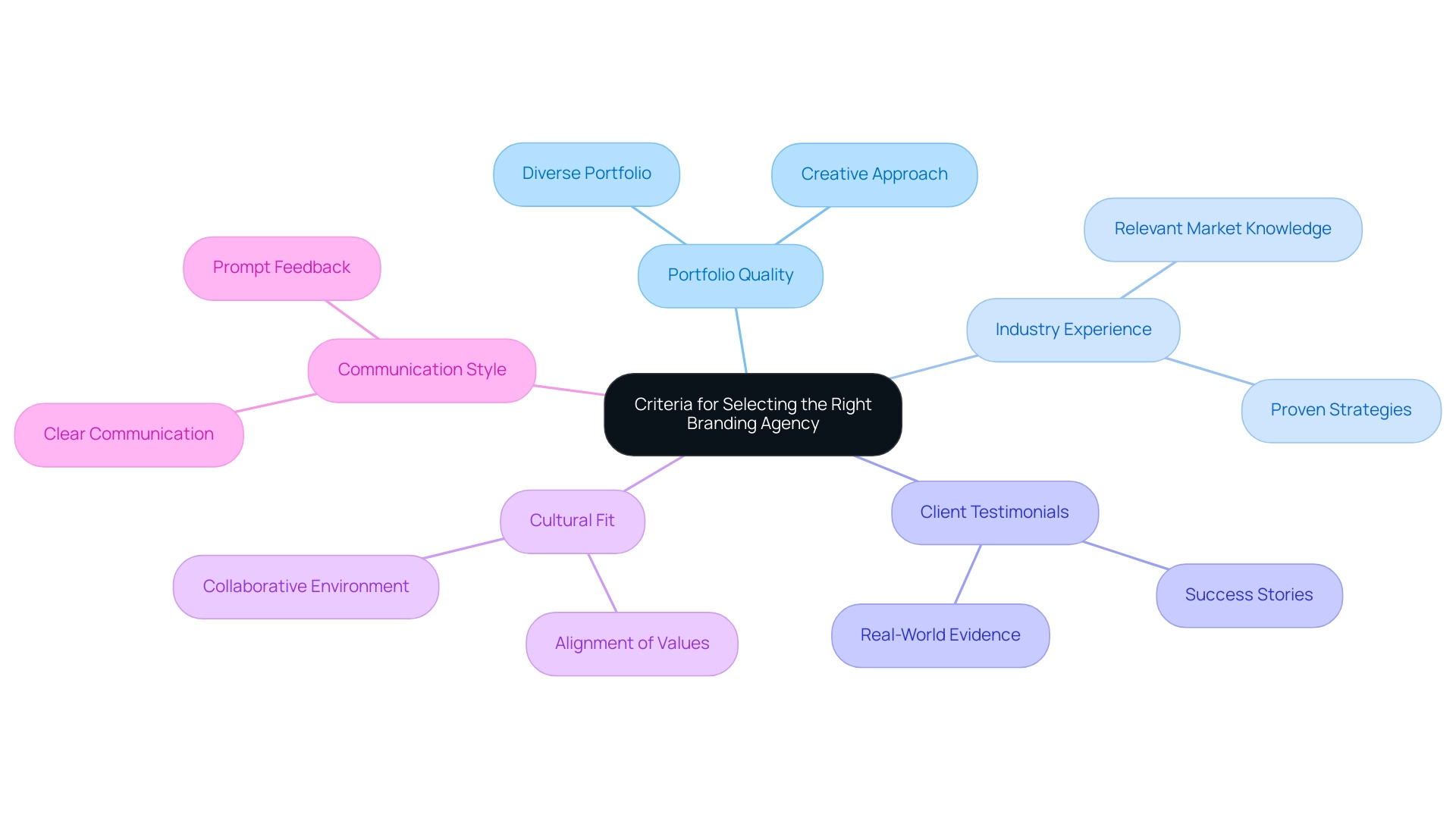
Navigating Brand Consistency: Challenges and Solutions for Brand Managers
Maintaining consistency in identity poses significant challenges for organizations, particularly those managing multiple products, services, or locations. Key obstacles include decentralized decision-making, which can lead to inconsistent interpretations of guidelines, and the necessity for marketing and branding agencies to adapt their strategies to diverse local market conditions. The notable 10.1% decrease in trademark applications at the U.S. office in 2023 underscores the growing complexities companies face in establishing a cohesive identity in a competitive landscape, highlighting the critical role of managers in navigating these challenges.
To effectively tackle these challenges, managers should prioritize the establishment of clear and comprehensive guidelines. These guidelines function as a foundational tool for ensuring that all team members comprehend the organization’s vision and values. Additionally, offering training for internal teams is essential; it enables employees to represent the identity consistently across all touchpoints.
Utilizing centralized tools for asset management can significantly enhance consistency across the organization. These tools, including templates, automate the application of guidelines, ensuring that all communications are presented uniformly and efficiently. Regular audits and feedback loops are also essential, as they allow organizations to assess the effectiveness of their marketing and branding agencies’ efforts and make necessary adjustments to align with the established identity.
Insights from marketing and branding agencies highlight the significance of maintaining relevance in a dynamic marketplace. As Chris Ross, Vice President Analyst at Gartner, notes, “Brand relevance and resonance can be extremely fluid based on a polarized marketplace, new disruptive business models, and ever-changing consumer requirements.” This emphasizes the necessity for marketing and branding agencies to remain agile and responsive to market dynamics, reinforcing the significance of adaptability in management.
To maintain cross-channel identity consistency, organizations can follow five key steps:
- Having a clear branding concept
- Creating a style guide
- Ensuring cross-channel integration
- Training the team
- Performing regular audits
These steps offer a systematic method for product managers at marketing and branding agencies to execute successful plans.
Case studies, like the extensive campaign for Quaker Oats carried out by WonderEight, demonstrate effective approaches for preserving market coherence. The campaign not only resonated with the target audience but also resulted in heightened customer loyalty and sales, demonstrating the effectiveness of marketing and branding agencies in a well-coordinated marketing approach. By applying these approaches, organizations can navigate the intricacies of identity management and cultivate a robust, consistent presence across all channels.
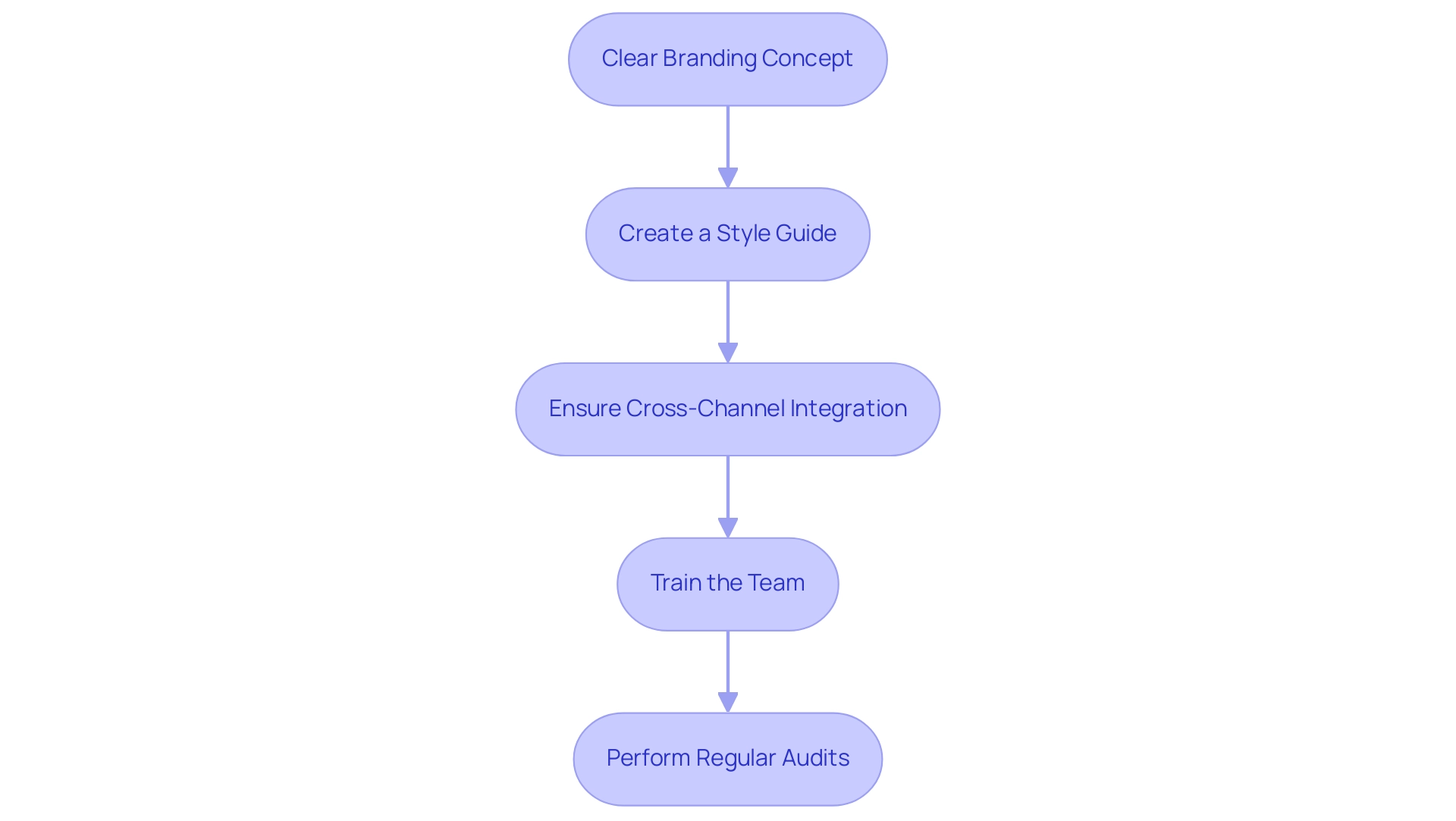
Case Studies: Successful Branding Campaigns and Their Impact
Examining effective marketing campaigns reveals essential insights for managers. A notable case is the rebranding of a prominent beverage company, which conducted an extensive market analysis to inform its strategy. This initiative included a refreshed visual identity and a targeted social media campaign, resulting in a remarkable increase in engagement and a significant boost in sales.
In 2025, statistics indicate that campaigns leveraging visual content, such as images, generate 650% higher engagement compared to text-only posts. This underscores the effectiveness of a visually driven approach.
Another compelling example is a tech company’s launch of a new product line, which effectively utilized influencer partnerships and experiential marketing to generate excitement and consumer interest. This campaign not only showcased the product’s features but also fostered authentic connections with the audience, demonstrating the power of strategic collaborations.
These case studies illustrate the necessity of strategic planning, creativity, and adaptability in branding efforts. Furthermore, companies are increasingly encouraged to initiate user-generated content (UGC) campaigns that inspire genuine customer experiences. By defining clear objectives and understanding their audience, companies can create compelling calls-to-action that enhance engagement.
A dedicated content producer is often essential to ensure high-quality content that resonates with consumers.
The case study titled ‘Strategic Tips for Launching UGC Campaigns’ emphasizes that to successfully launch a UGC campaign, companies should define clear goals, understand their audience, and create compelling calls-to-action. An omnichannel approach to repurposing UGC across various marketing channels can further amplify customer interaction, leading to improved marketing outcomes.
Ultimately, the lessons derived from these successful campaigns emphasize the profound effect that marketing and branding agencies have on business success. They highlight the necessity for thorough market analysis and innovative execution to achieve measurable outcomes. Significantly, WonderEight’s campaigns for companies like Miranda and Quaker Oats illustrate how effective strategies from marketing and branding agencies can result in substantial engagement and sales growth. This underscores the agency’s diverse client portfolio across sectors such as Technology, F&B, FMCG, Retail, Services, and B2B. Additionally, WonderEight measures ROI by ensuring the right message is delivered through tailored marketing solutions, reflecting its global reach with clients from cities like New York, Mumbai, Budapest, Paris, Jeddah, Tunis, Toronto, Kuwait, Muscat, and its home cities of Dubai, London, Riyadh, and Beirut.
Measuring Success: Key Metrics for Evaluating Branding Campaigns
To effectively assess the success of marketing campaigns, managers must prioritize key metrics such as awareness, customer engagement, and conversion rates, which are essential for marketing and branding agencies. A conversion rate of 3% or higher often indicates effective lead generation and sales performance. Furthermore, understanding Cost per Click (CPC) is crucial, as it reflects the amount spent for each click on a PPC advertisement; minimizing this cost while maintaining lead quality is vital for maximizing campaign effectiveness.
Tools like surveys, social media analytics, and website traffic analysis are indispensable for gathering valuable insights into how well the company resonates with its target audience.
In addition to these metrics, monitoring customer retention and loyalty is essential for evaluating the long-term effects of marketing efforts. For instance, a comprehensive campaign executed by WonderEight, one of the top marketing and branding agencies, for Quaker Oats not only enhanced visibility but also fostered positive consumer engagement, leading to improved metrics such as increased awareness and customer interaction.
Moreover, understanding Share of Voice (SOV) metrics can provide insights into a company’s presence compared to competitors, helping to gauge marketing effectiveness and identify growth opportunities. SOV measures a company’s share of the conversation in the market, which is vital for understanding competitive positioning. As noted by industry experts, “tracking your metrics provides important insights that can assist you in making better business decisions.”
By regularly evaluating these metrics, brand managers can refine their strategies and optimize future campaigns in collaboration with marketing and branding agencies, ensuring that their branding efforts yield measurable results and align with overall business objectives.
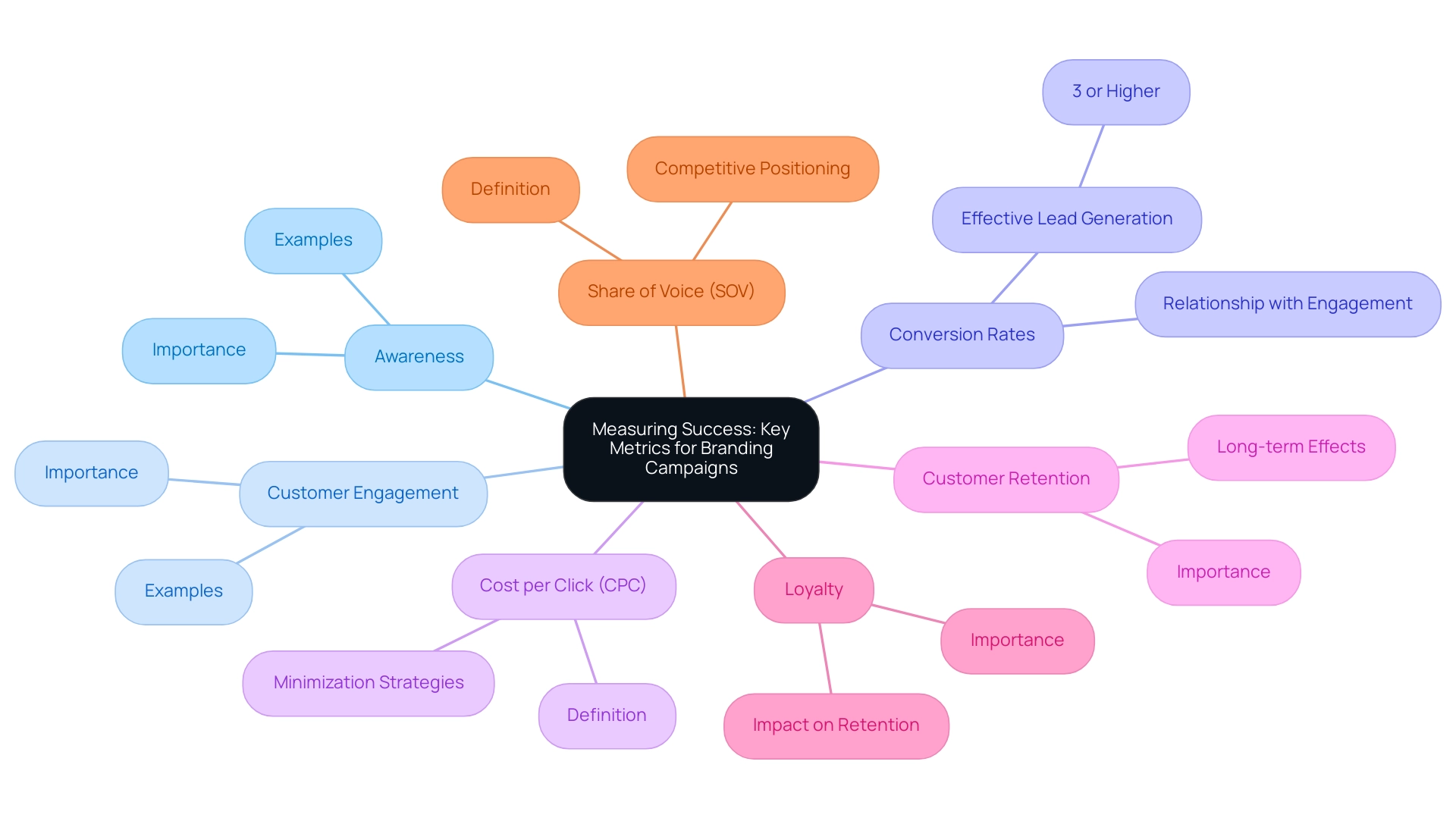
Conclusion
Understanding the distinction between marketing and branding agencies is essential for brand managers aiming to elevate their market presence and identity. This article has delved into the critical roles these agencies fulfill, underscoring the necessity of selecting the right partner aligned with specific needs and objectives. By acknowledging the distinct functions of branding agencies—particularly their emphasis on crafting a cohesive brand identity and nurturing consumer loyalty—brand managers can make informed decisions that resonate with their strategic goals.
Furthermore, the article elucidated the importance of key metrics for evaluating success, including brand awareness, customer engagement, and conversion rates. These metrics form the bedrock for assessing the efficacy of branding initiatives and refining strategies over time. As the branding landscape continues to evolve, it is imperative for businesses to adopt innovative strategies and leverage the expertise of specialized agencies like WonderEight to adeptly navigate the complexities of brand management.
In conclusion, collaborating with a branding agency transcends mere tactical choice; it emerges as a strategic necessity in today’s competitive arena. By fostering a partnership with the right agency, brand managers can amplify their brand identity, stimulate engagement, and ultimately secure measurable business outcomes. Embracing the insights and best practices delineated in this article will empower organizations to thrive in an ever-evolving marketplace.
Frequently Asked Questions
What roles do marketing and branding agencies play for businesses?
Marketing and branding agencies help businesses develop and implement strategies to enhance their image and market visibility. They conduct market research, develop strategies, create designs, and execute digital marketing initiatives.
How do these agencies help clients articulate their value propositions?
Their primary objective is to empower clients to effectively communicate their unique value propositions, engage with target audiences, and achieve measurable business outcomes.
What is the significance of identity in consumer recognition?
Identity plays a critical role in consumer recognition, with statistics showing that a signature color can boost recognition by as much as 80%. This highlights the importance of strategic marketing in cultivating customer loyalty.
What services do agencies like WonderEight offer?
WonderEight offers a comprehensive suite of services including social media planning, online and offline campaigns, events and activations, digital audits, website and app design and development, SEO consulting, and e-commerce CRM planning.
Can you provide an example of a successful marketing strategy by WonderEight?
WonderEight collaborated with Quaker Oats to design a tailored marketing strategy that significantly improved the company’s market presence and consumer engagement.
What emerging trends are influencing marketing strategies?
Trends such as highlighting popular products can substantially influence conversion rates, showcasing the nuanced strategies employed by marketing firms.
How do marketing and branding agencies differ from promotional firms?
Marketing and branding agencies focus on creating and maintaining a company’s identity and promoting products or services through various channels, whereas promotional firms concentrate on developing and executing paid marketing campaigns aimed at specific target audiences.
What should managers consider when choosing between marketing and branding agencies?
Managers should evaluate their specific needs and objectives, such as whether they require product development, market penetration, or targeted advertising campaigns.
What is the projected growth of the marketing sector?
The marketing sector is projected to grow to $769.9 billion by 2024, reflecting a recovery largely driven by advancements in artificial intelligence.
How does WonderEight differentiate itself in the market?
WonderEight sets itself apart by offering creative identity and digital solutions tailored to meet the unique needs of each client, helping managers navigate the complexities of today’s market.



